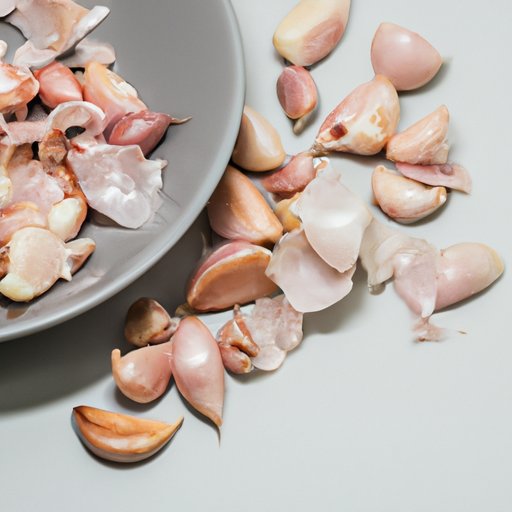
Introduction
Garlic is an essential ingredient in many dishes and is highly valued for its health benefits. However, using bad garlic can ruin the flavor of a meal and even pose a potential health risk. It’s important to be able to identify whether garlic has gone bad or not to avoid these issues. In this article, we’ll explore how to tell if garlic is bad and what causes it to spoil.
Five Signs Your Garlic Has Gone Bad: A Guide to Avoiding Spoiled Cloves
There are five main signs that garlic has gone bad, which are discoloration, softness, an unpleasant smell, sprouting, and moldy appearance. Discoloration is when the garlic turns yellow or brown. Softness is when the cloves feel mushy or slimy. An unpleasant smell is often described as a sour or acidic odor. Sprouting is when green shoots start to grow out of the cloves, and moldy appearance is when the garlic has visible patches of mold.
Garlic spoils due to exposure to air, moisture, or heat. All of these factors contribute to the growth of mold and bacteria, which cause the garlic to rot. To prevent spoilage, it’s essential to store garlic correctly in a cool, dry place and ensure it’s used before its expiration date.
How to Tell if Garlic is Past its Prime: A Simple Guide to Spotting Bad Bulbs
There are simple techniques for checking if garlic is past its prime, such as the smell test, the sight test, and the touch test. The smell test involves smelling the cloves; bad garlic will have a sour or acidic odor, while fresh garlic has a spicy aroma. The sight test involves looking at the cloves for discoloration, sprouting, or moldy appearance. The touch test involves squeezing the cloves to feel for softness or sliminess.
Identifying bad garlic before using it is essential because it can spoil a whole dish and even pose a health risk. Spoiled garlic can contain harmful bacteria that cause food poisoning, which can lead to nausea, vomiting, and diarrhea.
Is Your Garlic Bad? Here’s How to Know: A Quick Overview
In summary, bad garlic can be identified by discoloration, softness, an unpleasant smell, sprouting, or moldy appearance. Simple techniques for checking if garlic is past its prime include the smell test, sight test, and touch test. Always discard bad garlic to avoid potential health risks.
Additionally, it’s best to avoid buying pre-peeled garlic, as it’s more likely to spoil quickly. It’s also important to wash your hands and any tools used to handle garlic to prevent the spread of bacteria.
Don’t Let Rotten Garlic Ruin Your Dish: How to Identify Bad Cloves
Preventing bad garlic from ruining your food begins with buying fresh garlic. Choose garlic bulbs with tight, firm cloves and avoid any with soft spots or discoloration. Proper storage is also crucial; garlic should be stored in a cool, dry place away from moisture and direct sunlight. Avoid bruising garlic, as this can cause it to spoil more quickly.
Following proper food safety practices is essential for avoiding the spread of bacteria and ensuring that your food is safe to eat. Always handle garlic with clean hands and wash any dishes or tools used to prepare it with hot, soapy water.
Simple Techniques for Checking if Your Garlic is Spoiled
To recap, the main techniques for checking if garlic is spoiled are the smell test, sight test, and touch test. If the garlic shows any signs of spoilage, it’s best to discard it to avoid potential health risks.
Always aim to buy fresh garlic, store it correctly, and avoid bruising it to prevent spoilage. By following these simple steps, you can ensure that you’re using good-quality garlic that adds flavor and nutrition to your meals.
Conclusion
In conclusion, identifying spoiled garlic is vital for preventing it from ruining your dishes and causing potential health risks. The five signs of bad garlic are discoloration, softness, an unpleasant smell, sprouting, and moldy appearance. Simple techniques for checking if garlic is bad include the smell, sight, and touch tests. Proper storage, buying fresh garlic, and avoiding bruising it are crucial for avoiding spoilage and ensuring good food hygiene. By following these guidelines, you can enjoy delicious meals with the full benefits of fresh, high-quality garlic.




